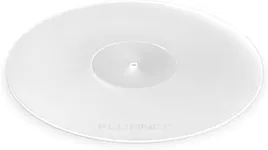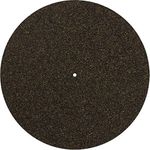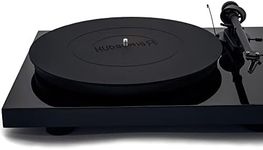Buying Guide for the Best Turntable Mats
Choosing the right turntable mat can make a noticeable difference in your vinyl listening experience. The mat sits between your record and the platter, and its main job is to provide a stable, vibration-free surface for your records to spin on. The right mat can help reduce unwanted noise, improve sound clarity, and even protect your records from scratches. When picking a turntable mat, it's important to consider the material, thickness, and compatibility with your turntable and listening preferences.MaterialThe material of a turntable mat is crucial because it affects how vibrations are absorbed and how the record interacts with the platter. Common materials include felt, rubber, cork, leather, and acrylic. Felt mats are soft and affordable, often used for DJing because they allow for easy record slipping, but they can attract dust. Rubber mats are heavier and provide good grip and vibration damping, making them suitable for home listening. Cork mats are lightweight and help reduce static, while leather mats offer a balance of grip and anti-static properties. Acrylic mats mimic the feel of a glass platter and can enhance clarity. To choose the right material, think about whether you prioritize sound clarity, static reduction, or ease of use for DJing or casual listening.
ThicknessThickness refers to how tall the mat is, usually measured in millimeters. Thicker mats can help dampen more vibrations and may slightly change the sound by adding warmth or reducing brightness. However, a mat that's too thick can affect the height of your tonearm, which might impact tracking and sound quality. Thin mats are less likely to interfere with your turntable's setup but may offer less vibration control. If you want to experiment with sound or need extra vibration damping, a thicker mat might be best. If you want to keep your setup simple and close to the original design, a thinner mat is a safer choice.
Grip and SlipGrip and slip describe how much the mat holds onto the record or allows it to move. Mats with more grip, like rubber or cork, keep the record firmly in place, which is ideal for home listening and sound quality. Mats with more slip, like felt, are preferred by DJs who need to cue and scratch records. If you mostly listen to records at home and want the best sound, choose a mat with good grip. If you plan to DJ or want to move records easily, a mat with more slip is better.
Static ControlStatic control is important because static electricity can attract dust to your records and cause pops or crackles during playback. Some materials, like cork and leather, naturally reduce static, while others, like felt, can increase it. If you live in a dry climate or notice a lot of static when handling your records, look for a mat that helps control static. This will keep your records cleaner and improve your listening experience.
CompatibilityCompatibility means making sure the mat fits your turntable's platter in terms of size and weight. Most mats are designed for standard 12-inch platters, but some turntables have unique sizes or designs. Also, some turntables are calibrated for a specific mat thickness, so changing to a much thicker or thinner mat might require adjusting your tonearm height. Always check your turntable's manual or measure your platter before buying a new mat to ensure a good fit and avoid any setup issues.














